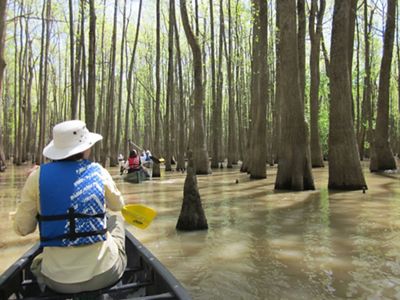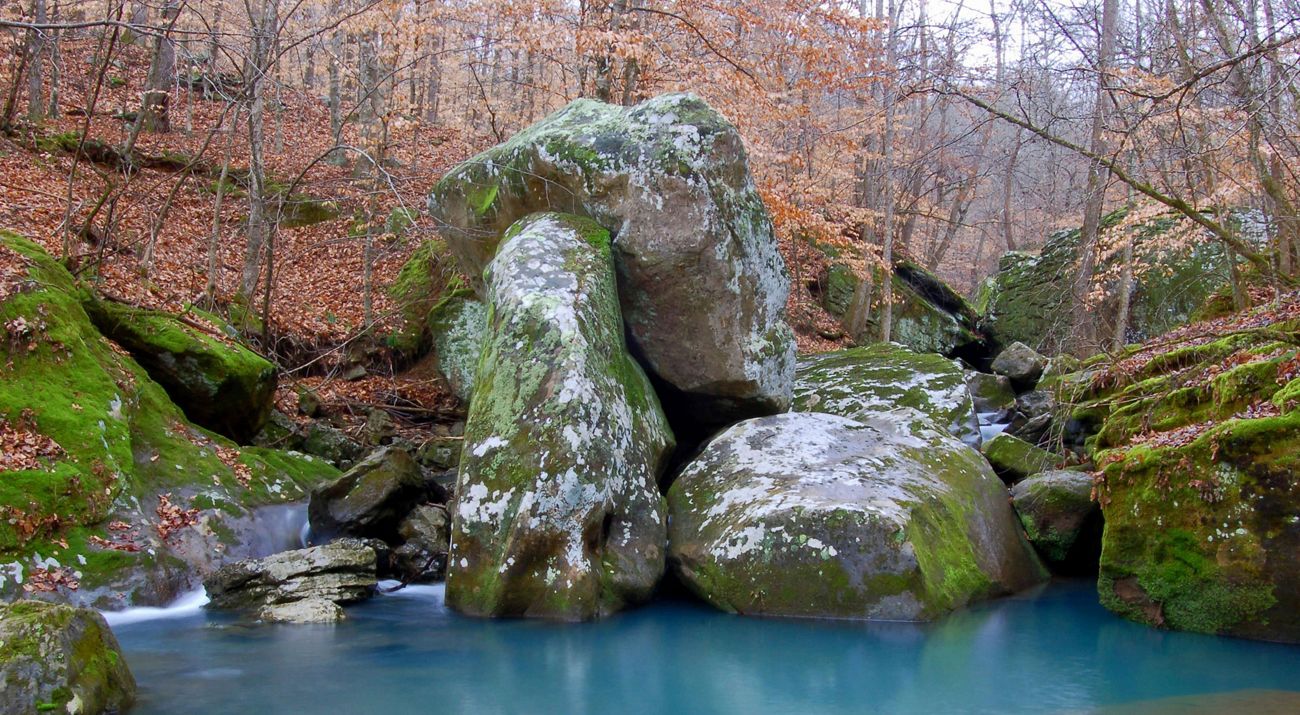
1982 — The Nature Conservancy creates its Arkansas Chapter, the 29th in the United States, with a $1 million challenge grant from the Winthrop Rockefeller Foundation. The Conservancy has already been at work in Arkansas since the 1970s, acquiring lands that become Hobbs State Park-Conservation Area, Overflow National Wildlife Refuge and Logoly State Park. In 1978 cooperative efforts of the Conservancy and the Arkansas Natural Heritage Commission launch the Arkansas Natural Heritage Inventory Program, the central repository of data on the state’s biodiversity.
1984 — The Conservancy purchases 5,570 acres in Pulaski and Lonoke counties that are transferred to the state to form Holland Bottoms Wildlife Management Area. It is one of the most extensive remaining bottomland areas in central Arkansas and conserves significant habitat for migratory waterfowl and other native wildlife.
1986 — The Cache River National Wildlife Refuge is established with the transfer of 380 acres of land from the Conservancy to the U.S. Fish and Wildlife Service and with legislation supported by U.S. Senators Dale Bumpers and David Pryor.
1987 — By purchasing and transferring 4,400 acres to Arkansas State Parks and Arkansas Natural Heritage Commission, the Conservancy helps create the Cossatot River State Park-Natural Area.
1989 — The Conservancy and the Arkansas Natural Heritage Commission purchase Lorance Creek Nature Preserve, which now includes 525 acres, part of which is the Commission’s Lorance Creek Natural Area. The Natural Area features interpretive signs along a boardwalk extending into the tupelo-cypress bottomland forest.
1989 — The Conservancy acquires 3,667 acres at the current headquarters of the Cache River NWR. Through the 1980s, the Conservancy is instrumental in acquiring more than 9,000 acres in the Arkansas Delta, much of it targeted for reforestation and inclusion in the Cache River refuge. By 1999, Arkansas becomes one of the top 10 states participating in the Wetlands Reserve Program, with more than 130 landowners enrolling 35,720 acres in the program.
1991 — The Arkansas Natural Heritage Commission and the Conservancy establish Terre Noire Natural Area in the rare blacklands ecosystem. A later partner-led assessment gives a complete picture of conservation needs, and subsequent acquisitions and landowner agreements result in thousands of acres in conservation ownership and management. Blacklands conservation is strengthened with the Arkansas Game and Fish Commission’s acquisition of the 4,885-acre Rick Evans Grandview Prairie Wildlife Management Area in 1997.
1992 — The 41,000-acre Arkansas/Idaho land exchange is accomplished by the Conservancy, Senators Dale Bumpers and David Pryor, U.S. Fish and Wildlife Service, Bureau of Land Management, and Potlatch Corporation to create a 160-mile protected corridor along the White River connecting the Cache River and White River refuges. The exchange, with a land value in excess of $20 million, is accomplished at virtually no cost to the taxpayer.
1995 — The Conservancy establishes its Arkansas fire restoration program, which now consists of two burn crews that have restored fire to more than 60,000 acres of public and private land in the state. Three years later, the Conservancy teams with the Arkansas Natural Heritage and Arkansas Game and Fish commissions as well as the U.S. Forest Service and the U.S. Fish and Wildlife Service to develop a state prescribed fire workshop program, which has trained more than 500 natural resource managers so far.
1996 — The Conservancy teams with many partners to help pass the state 1/8-cent Conservation Sales Tax, which is used to purchase and protect natural lands.
1996 — Using data from a 13-month-long Conservancy ecological assessment, Senator Dale Bumpers, Weyerhaeuser Company, the U.S. Forest Service and the U.S. Fish and Wildlife Service complete the Arkansas/Oklahoma land exchange, an act that adds more than 133,000 acres to public conservation ownership in the Ouachita Mountains. Between 1998 and 2000, the Conservancy also works with Sen. Bumpers to add 9,000 more acres to the Ouachita National Forest.
1997 — More than 100,000 acres are enrolled in a newly created ecological restoration program managed by the Conservancy and the Arkansas Natural Heritage Commission. The project includes the implementation of stewardship plans at 12 sites across the state. Also, the Conservancy enters into a restoration agreement with Pine Bluff Arsenal on 6,000 acres and in the following year with Fort Chaffee on 55,000 acres.
1998 — With the gift of Bear Hollow Cave from the John Cooper family, the Conservancy increases the scope of its karst work in Arkansas. In the following years, the karst program describes 20 species new to science, protects several caves, installs or repairs 24 cave gates, and cleans up 230 tons of trash from cave recharge areas. In recent years, urban planners and developers have used Conservancy karst sensitivity maps to safeguard endangered and rare species habitat as well as areas especially sensitive to groundwater contamination.
1999 — With support from the Walton Family Foundation, the Arkansas program begins site-based programs in three areas: the Ozark karst ecosystem, the Strawberry River watershed and the Big Woods.
2001 — In response to the red oak borer outbreak in the Interior Highlands, a multi-partner oak ecosystem restoration team is established and more than 200,000 acres of woodland restoration sites are created in the following years. Monitoring soon shows benefits of prescribed burning and ecological thinning at the sites, leading to a significant increase in these activities throughout the state.
2002 — With the creation of the 820-acre Kingsland Prairie Preserve, the Conservancy begins its conservation forestry program, which tests economical practices that maintain habitat and which is now applied to a dozen sites statewide.
2003 — Fred Berry makes a lead gift to launch the Conservancy’s Ozark Rivers Legacy Program, an effort that brings together state, federal and private partners to address declining water quality in Ozark streams and rivers. With a gift from Anderson-Tully Company, the Conservancy launches the Lower Mississippi River Program to support conservation within seven Delta states.
2004 — An ivory-billed woodpecker is observed and confirmed in the Big Woods. With the rediscovery, the Conservancy accelerates its efforts in the Big Woods, helping conserve some 15,500 acres and planting more than two million trees.
2005 — The Conservancy creates Smith Creek Preserve with the bargain purchase of 1,226 acres above Sherfield Cave. The preserve connects the Ozark National Forest and the Upper Buffalo Wilderness Area and protects endangered Indiana bats. In the same year, the Conservancy begins its Ouachita Rivers Program, initially focused on the Saline and Caddo rivers.
2006 — The Conservancy and the Arkansas Game and Fish, Arkansas Natural Heritage and Arkansas Forestry commissions purchase a 16,000-acre working-forest conservation easement from Potlatch Forest Holdings, Inc. Slated to open as the Moro Big Pine Wildlife Management Area and natural area, the project protects native loblolly-shortleaf pine forests and wildlife, including the red-cockaded woodpecker.
2007 — The Delta program team restores a ditched section of Benson Slash Creek using natural channel design techniques. This demonstration site will inspire many other such restorations in the years ahead.
2008 — Through the donation of a 2,900-acre conservation easement from the Calion Lumber Company, the Conservancy creates the Ouachita River Nature Preserve. The preserve includes six miles of frontage along both sides of the lower Ouachita River and is made up of old-growth bottomland hardwoods.
2009 — The Conservancy completes restorations of heavily eroding stream banks on forks of the Little Red River and Saline River. More such restorations follow, along with workshops and demonstrations across the state showcasing construction and maintenance techniques to reduce erosion from unpaved roads.
2010 — With the help of generous donors, the Conservancy establishes the Kings River Preserve along seven miles of this nationally designated Wild and Scenic River. The conservation of 2,427 acres by the Conservancy and Arkansas Natural Heritage Commission—with funding from federal, state and private partners—doubled the size of the Commission’s Warren Prairie Natural Area, one of the coastal plain’s best examples of native pine and oak flatwoods and saline barrens.
2011 — After years of preliminary work by the Corps of Engineers, Ducks Unlimited, and Arkansas Game and Fish Commission, and with further support from the City of Clarendon, Arkansas Natural Heritage Commission and U.S. Fish and Wildlife Service, the Conservancy secures an agreement with the Corps to restore a 4.6-mile stretch of the Cache River that was channelized in the 1970s. The Conservancy launches a fundraising campaign for the restoration and serves as the project overseer.
2012 — Crews plant half a million hardwood seedlings in the Cache River bottomlands, part of four million trees that will be planted through a federal Wetlands Reserve Enhancement Program. The Conservancy, Ducks Unlimited and Natural Resources Conservation Service teamed up to help landowners enroll in the voluntary program.
2013 - The Arkansas Association of Counties, the Arkansas Association of Conservation Districts, Arkansas Farm Bureau, The Nature Conservancy and a dozen public and private partner organizations joined forces to establish the Arkansas Unpaved Roads Program.
2014 -Through a partnership led by the United States Army Corps of Engineers and supported by The Nature Conservancy, Arkansas Game and Fish Commission, Ducks Unlimited and the City of Clarendon, four of the seven miles channelized in the 1970s were restoreed. Businesses, private donors, foundations, and other organizations contributed over $2.8 million to provide the needed match to federal funding to make the project a reality.
2015 - Phases one and two of the restoration on the Archey Fork of the Little Red River are complete, with yellow cheek darters moving in almost instantly!
2015 - Kirsch Preserve at Ranch North Woods along the Little Maumelle River opens. The first urban preserve for TNC in Arkansas.
2016 - A donation of $6 million is made by BHP to establish the Sustainable Rivers and Forests Initiative and support conservation work in the Greers Ferry watershed.
2017 - One new preserve is opened (Council Rock Forest), 500,000 trees are planted in the Delta, 10 new upaved roads projects are completed, and five new trails are established at preserves across the state.
2018 - Thanks to generous support from the Lee Bodenhamer Family, TNC and the Arkansas Natural Heritage Commission, a division of the Department of Arkansas Heritage, open Rattlesnake Ridge Natural Area, just outside of Little Rock.
Looking forward, The Nature Conservancy will continue working cooperatively with private landowners, businesses, public agencies, and other organizations to conserve and restore the lands and waters of the natural state for people to enjoy for the next 30 years.
